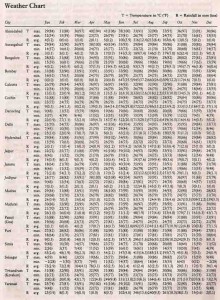Whatever the time of year, there is always somewhere in India where you can enjoy a relaxing and memorable vacation. But the climate varies, depending on season and location, and you need to consider this when planning your holiday. The country has four seasons—spring, autumn and two monsoons. The south-west monsoon starts in June on the west coast and slowly wends  its way northwards; the north-east monsoon takes place between October and December. This can actually be a most pleasant time to go. In between the sudden, short downpours of rain are periods of clear, brilliant sunshine, and all the foliage and flowers suddenly burst into colour. It’s a photographer’s dream, and the heat at such times is rarely unbearable.
its way northwards; the north-east monsoon takes place between October and December. This can actually be a most pleasant time to go. In between the sudden, short downpours of rain are periods of clear, brilliant sunshine, and all the foliage and flowers suddenly burst into colour. It’s a photographer’s dream, and the heat at such times is rarely unbearable.
The movements of foreign tourists tend to follow a set pattern. From November to January, you’ll find many travellers in the south. It’s always hot in the south, but this is the coolest season. By February, the annual migration northwards has begun. Travellers move slowly up the western coast, settling briefly in Kovalam and Goa between February and early March, before heading up to Bombay, Calcutta and Delhi by mid- to late March. These are the three main jump-off centres for, respectively, Kashmir, Darjeeling and Nepal. At the time of writing, continuing political unrest makes Kashmir an unsafe destination, but the cool mountain resorts of the north are where the bulk of travellers relax between April and June. Then come the monsoons, and it’s only in the autumn, from October onwards, that tourists re-appear in any force, usually to take in the clear mountain views and beautiful plants and flowers that blossom in the wake of the rains.
As a general guide, Delhi and Rajasthan (along with the cities of the northern plains) are most pleasant from late September until late March, very hot during April and May, and receive the rains from mid-June. Bombay and Goa are best during November to February, thereafter hot and humid until the monsoons break in early June. South India is coolest from November to April, and gets the rains as early as late May. Ladakh is snowbound for half the year, and can be visited from May to October only.
Most foreign tourists visit India in season, to enjoy the best weather and facilities, and to meet other travellers. A cunning minority go off season—usually a week or two before everybody else—to take advantage of the 30-50% accommodation discounts offered by Goan beach-huts and hill station hotels. Travelling off season also means fewer crowds, more seats on buses, and no long queues for train tickets.
Don’t travel north during May and June. In early May Indian schools break up. This is the cue for a mass exodus of home tourists to Darjeeling and Shimla, and practically everywhere else that qualifies as a holiday or honeymoon resort. Secondly, try to avoid Bombay, Calcutta, or Delhi during March. All three centres are crowded out with travellers then, and finding accommodation can be very difficult.

